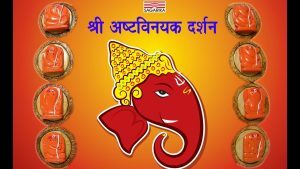A Divine Road Trip: Exploring 5 Jyotirlinga and Ashtavinayak Temples from Pune
Introduction: A Sacred Journey Begins
In the heart of Maharashtra lies a spiritual journey like no other — a path that winds through sacred temples, ancient legends, and breathtaking landscapes. From the bustling city of Pune, pilgrims and travelers alike set out on a unique and soul-enriching tour that combines two of the most revered spiritual circuits in India: the Ashtavinayak Yatra From Pune and the 5 Jyotirlinga Darshan.
Whether you’re seeking divine blessings, planning a family pilgrimage, or simply wanting to explore Maharashtra’s cultural richness, this combined tour offers a seamless blend of devotion, tradition, and scenic travel.
Let’s dive deep into this extraordinary tour — the temples, the route, the history, and how to plan the perfect trip from Pune.
Part 1: Ashtavinayak Yatra – The 8 Sacred Ganpati Temples
The Ashtavinayak Yatra takes you on a journey to eight ancient temples of Lord Ganesha, each one deeply connected with mythology and miracles. These temples are located in different parts of Maharashtra, but the beauty is — you can complete the full circuit in 2 to 3 days starting and ending at Pune.
1. Mayureshwar – Morgaon
Known as the starting and ending point of the Ashtavinayak Yatra, Morgaon’s Mayureshwar Temple is the spiritual hub. Here, Lord Ganesha is worshipped as riding a peacock, symbolizing strength and intelligence.
2. Siddhivinayak – Siddhatek
Located on the banks of the Bhima River, this temple is believed to grant spiritual enlightenment. It’s the only Ashtavinayak temple where devotees must circumambulate the entire hillock for blessings.
3. Ballaleshwar – Pali
This is the only temple where Lord Ganesha is known by the name of his devotee, Ballal. The temple has a unique design — its sanctum is shaped like the letter “Shri.”
4. Varad Vinayak – Mahad
Situated in a serene village, this temple is known for fulfilling wishes. Unlike others, the idol here is self-manifested (Swayambhu) and devotees are allowed to enter the sanctum.
5. Chintamani – Theur
Located near Pune, this temple symbolizes peace of mind. Legend says Ganesha retrieved a precious gem and returned it to sage Kapila, thus earning the name Chintamani.
6. Girijatmaj – Lenyadri
A cave temple located on a hill, Lenyadri is unique — the only Ashtavinayak temple carved into rock and also the childhood home of Lord Ganesha, according to mythology.
7. Vighnahar – Ozar
This temple is known for removing obstacles and is particularly important for devotees seeking solutions to tough problems. The temple architecture and the positive aura here are remarkable.
8. Mahaganpati – Ranjangaon
The final temple on the Ashtavinayak route, Mahaganpati of Ranjangaon is the most powerful form of Lord Ganesha. It is believed that Shiva himself worshipped this form before fighting Tripurasura.
Part 2: The Sacred Jyotirlingas – 5 Powerful Shiva Shrines in Maharashtra
The Jyotirlingas are holy shrines where Lord Shiva is worshipped in the form of a fiery column of light. There are 12 Jyotirlingas across India, and Maharashtra proudly houses five of them. Each temple is a center of deep devotion, architectural beauty, and mythological richness.
1. Bhimashankar – Near Pune
Located in the Sahyadri Hills, Bhimashankar is surrounded by lush forests and wildlife. It is believed to be the place where Lord Shiva defeated the demon Tripurasura. The temple is a serene mix of spirituality and natural beauty.
2. Trimbakeshwar – Nashik
Home to the origin of the sacred Godavari River, this temple has a unique Jyotirlinga with three faces representing Brahma, Vishnu, and Shiva. The spiritual energy here is unmatched, and it’s also a popular stop during the Kumbh Mela.
3. Grishneshwar – Ellora (Verul)
Just a stone’s throw from the Ellora Caves, this is the last Jyotirlinga in the traditional list. The temple’s red rock architecture and proximity to UNESCO heritage sites make it both a pilgrimage and a tourist destination.
4. Aundha Nagnath – Hingoli District
Regarded as the first Jyotirlinga to exist, this temple is linked with many ancient texts. It features exquisite Hemadpanthi architecture and is less commercial, making the experience more serene and pure.
5. Parli Vaijnath – Beed District
This temple represents the healing form of Lord Shiva. It is believed that visiting Parli Vaijnath with true devotion can help cure physical ailments and grant peace of mind.
For Ashtavinayak Tours and 5 Jyotirlinga tours from Pune, ideal vehicle options include 9 seater Tata Winger, 12 Seater Tata Winger, 13 Seater Tata Winger, 15 Seater Tata Winger, new Tata Winger Premium 9 Seater Luxury VVIP duty, and 17 seater Tempo Traveller also 20 seater Tempo Traveller, Urbania (17–20 seater), and large 45 Seater or 49 seater, 50 Seater buses for big groups. The route typically starts with Ashtavinayak temples following the Shastrokta sequence, then continues to Bhimashankar Tours, Trimbakeshwar Tours, Grishneshwar Tours, Parli Vaijnath Yatra, and Aundha Nagnath Jyotirlingas Tours. The entire trip takes around 5 to 7 days. October to March is the best season for travel due to pleasant weather. For peak weekends or festivals, advance booking is recommended to secure preferred vehicles and smooth itinerary planning.


